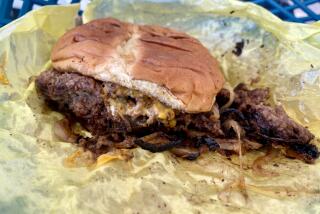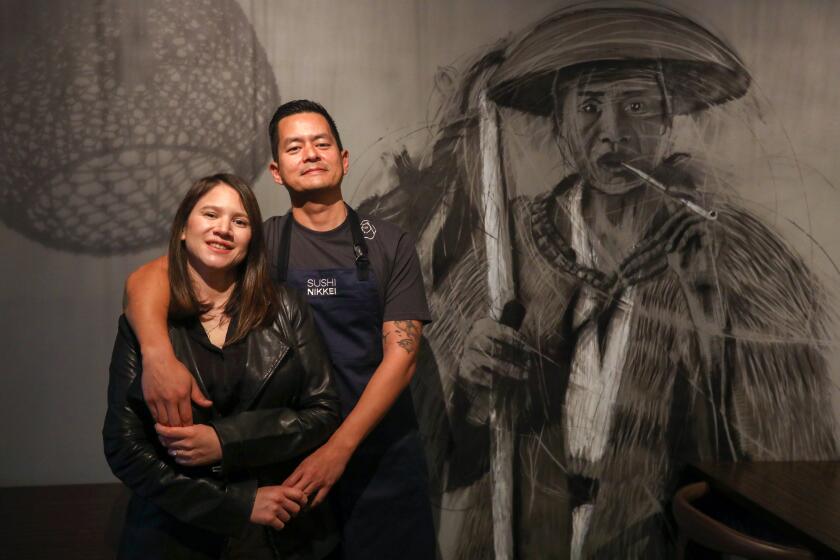French for revelry
FOOD is almost religion to the French, but never more so than at the holidays. One of the most alluring traditions from a country that invented foie gras and perfected chocolate is reveillon, the late-night feast on Dec. 24, the early-morning feast on Dec. 25 and, for good measure, the anytime feast on New Year’s Eve or Day.
Reveillon originated as the celebratory meal after midnight mass in a heavily Catholic country, but everything about it is made for multicultural modern America.
For the record:
12:00 a.m. Dec. 28, 2005 For The Record
Los Angeles Times Wednesday December 28, 2005 Home Edition Food Part F Page 3 Features Desk 0 inches; 33 words Type of Material: Correction
Foie gras -- An article in last week’s Food section on reveillon said foie gras was invented in France. The practice of force-feeding geese to yield fatty livers was developed in ancient Egypt.
For The Record
Los Angeles Times Wednesday December 28, 2005 Home Edition Main News Part A Page 2 National Desk 1 inches; 34 words Type of Material: Correction
Foie gras -- An article in the Dec. 21 Food section on reveillon said foie gras was invented in France. The practice of force-feeding geese to yield fatty livers was developed in ancient Egypt.
The whole focus is on luxury and indulgence.
A typical meal starts with plenty of caviar or oysters or foie gras (or all three), proceeds through some variation on turkey or goose, and winds up with a buche de Noel, the cake decorated to look like the yule log. Depending on the region or the players, the menu can be expanded to include smoked salmon or lobster to begin and no fewer than 13 desserts to end.
“Reveillon de Noel is to France what Thanksgiving is to America,” said Ariane Daguin, who owns the foie gras and game purveyor D’Artagnan.
“Once a year you get the family together” and eat almost to excess. Reveillon on New Year’s Eve, she added, is when the French feast with friends.
Every family has its own version of the traditional menu.
For instance, Joel Robuchon, the renowned chef who has restaurants in Paris, Tokyo, Macao and Monaco and has recently opened in Las Vegas, says what will come out of his home kitchen in Paris includes caviar and smoked salmon, classic lobster a l’americaine, roast chicken with foie gras and truffles, and a refreshing salad of oranges, dates and nuts perfumed with orange flower water and garnished with mint.
*
Chefs celebrate
YOU won’t see reveillon mentioned on the menu at many French restaurants in Los Angeles, but tradition drives the Christmas Eve choices nonetheless.
Ortolan is offering a gussied-up variation on the typical lineup, including scallop ceviche; celeri remoulade and duck crisp; oysters; langoustines in ravioli with black truffles; lobster gratinee with ginger; capon with foie gras and truffles; and, of course, la buche.
La Cachette also will serve the cake log, but after venison, duck or cod.
“We celebrate at the restaurant, not at home, because we’re working,” said Jean Francois Meteigner, La Cachette’s chef-owner. And just like in France, Christmas Eve will involve more families with children, while New Year’s Eve will be more couples and groups of friends, he said.
Ortolan’s executive chef-owner, Christophe Eme, waits for his feast until Christmas or the day after, when the restaurant is closed and he can have friends and some staff to his home. This year he intends to do a menu that includes venison, fish and the requisite buche de Noel.
“We have some Champagne, we play cards,” he said. His family in France always served seven or eight courses, starting with oysters and salmon and moving on to fish and a turkey or goose.
Daguin, who this year will be feeding her parents (her father is a renowned Gascon chef), said she starts with oysters, chicken sausage with truffles, some type of “big bird,” a side dish of chestnuts, a green vegetable, a big salad and a chunk of cheese such as Roquefort.
Turkey, goose or capon are all good candidates for the bird because they have enough meat to feed a large group, she added, but the main course can also be a ham or roast.
“By popular re-demand,” she said, she stuffs the bird under the skin with truffle butter before roasting it, to flavor and perfume the flesh.
Chestnuts are often used as stuffing for reveillon birds, because they soak up the cooking juice so well. But Daguin, over the years, has made a recipe from Robuchon’s “Simply French” cookbook her own: to his confit of chestnuts with pearl onions and fennel she adds a hefty dose of garlic, and substitutes demi-glace for chicken stock for braising, which creates a far more intense flavor.
Easily the most essential ingredient in reveillon is the buche de Noel, the classic roulade swathed in chocolate icing. Larousse Gastronomique says it was created sometime after 1870 to replicate the log traditionally burned in the fireplace at Christmastime.
Too often the buche starts with an airy roulade and is more about the frosting than the cake. But the one created by Michelle Myers, chef-owner of Boule and pastry chef at Sona in West Hollywood, is a flourless chocolate cake with an amazing texture, velvety with a very fine, tender crumb, and with an apricot filling.
The intense flavor comes from dark chocolate with at least 60% cacao, such as Valrhona Caraibe (66%).
*
A dozen more desserts
FOR all the popularity of the buche, it is not always a solo performer. Marrons glaces -- glazed chestnuts -- are almost as important to the holiday as the buche; a box of the fancy confections are just the thing to tuck under your arm on the way to a reveillon dinner.
On the Daguin table, the buche will be joined by a dozen more desserts.
“My grandmother was from St.-Remy, and in Provence, they have 13 desserts,” she said. “It’s a religious thing,” symbolizing Jesus and his apostles at the Last Supper.
Her selection can include choices as simple as clementines, dates, figs or a bowl of almonds, or as store-bought-fancy as French macaroons and good chocolates, or the Provencal confections called calissons, made from almonds and candied fruit.
Since reveillon originated in the land of the health paradox, wine figures prominently in any celebration. Daguin said her table always has Champagne with the appetizers, then white wine, then red and finally more Champagne with dessert.
What makes reveillon worth emulating in this country is that it is as much about smart shopping as it is about cooking.
Foie gras, raw oysters, caviar and chestnuts are all a matter of picking and unpacking. The right big bird, stuffed with truffle butter, does not even need a sauce. And no stigma is ever attached to a buche de Noel from a good bakery.
*
Braised chestnuts with fennel and onions
Total time: About 1 1/2 hours
Servings: 4 to 6
Note: This is a version of a Joel Robuchon recipe adapted by Ariane Daguin. Demi-glace is available at specialty food markets.
1 pound fresh chestnuts
Salt to taste
1 sprig fresh thyme
1 sprig fresh parsley
Leaves from 1 stalk celery
5 tablespoons unsalted butter, divided
3 cloves garlic, peeled and minced
1/2 cup demi-glace
20 pearl onions
1 tablespoon sugar
1 small fennel bulb with fronds
Freshly ground black pepper to taste
1. Bring a large pot of water to a rolling boil. As it heats, cut an X into the flat side of each chestnut. Add about 1 tablespoon of salt to the water, then add the chestnuts. Boil until tender, about 20 to 24 minutes. Cool, then remove the shells and inner skins. Set aside.
2. Tie the thyme, parsley and celery leaves together with kitchen twine. Set aside.
3. Melt 4 tablespoons butter in a large, deep skillet over medium heat. Add the garlic and cook just until aromatic, 1 minute, then add the chestnuts and stir until they are coated with butter. Cook 5 to 10 minutes, stirring often, until they are golden. Stir in the demi-glace and one-half cup water. Lay the tied-together herbs on top of the chestnuts. Lower the heat and simmer, stirring occasionally, until the chestnuts are almost soft and the liquid is reduced to a glaze, about 15 to 20 minutes.
4. While the chestnuts cook, cook the onions. Trim the stem end and cut a small cross into the base of each onion. Blanch in boiling salted water for 2 minutes. Drain well, then peel. Combine the remaining tablespoon of butter with the sugar in a small saucepan. Add the onions and cook, stirring, until they are glazed, about 2 minutes. Cover the pan tightly and cook until the onions are tender, about 15 minutes. Shake the pan occasionally to keep the onions from burning.
5. Cut the fennel bulb into julienne strips about 1 1/2 inches long and chop the fronds coarsely. Stir the strips into the onions and cook, stirring, until softened, about 5 minutes.
6. When the chestnuts are cooked, remove and discard the herb bundle. Stir in the onion mixture. Season with salt and pepper to taste. Just before serving, stir in the fennel fronds, adding some as a garnish.
Each of 6 servings: 300 calories; 8 grams protein; 41 grams carbohydrates; 3 grams fiber; 12 grams fat; 6 grams saturated fat; 25 mg. cholesterol; 424 mg. sodium.
*
Scallop ceviche with caviar
Total time: 10 minutes, plus 1 hour marinating time
Servings: 4
Note: From Christophe Eme at Ortolan
16 bay scallops
2 tablespoons freshly squeezed lime juice
1 tablespoon freshly squeezed lemon juice
2 tablespoons top-quality olive oil
Sea salt, preferably
Maldon
1/2 teaspoon minced
seeded serrano chile
1/2 ripe but firm Hass
avocado
Freshly ground black pepper
1 to 2 ounces domestic black caviar, depending on your budget
2 tablespoons chopped chives
1. Rinse the scallops and remove their tendons. Place them in a small glass bowl. Combine the lime and lemon juice with the olive oil, 1 teaspoon salt and the chile and pour over the scallops. Mix with a rubber spatula. Cover. Marinate 1 hour in the refrigerator, stirring occasionally.
2. Just before serving, seed and skin the avocado. Cut the flesh lengthwise to make 12 almost paper-thin slices. Arrange the slices to cover the center of each of 4 small serving plates, overlapping them very slightly. Season with salt and pepper to taste.
3. Drain the scallops and cut each one crosswise into 3 slices. Arrange 12 slices attractively over the avocado on each plate. Dot each slice with caviar. Sprinkle the chives around the perimeter of each plate and serve at once.
Each serving: 179 calories; 13 grams protein; 5 grams carbohydrates; 2 grams fiber; 12 grams fat; 2 grams saturated fat; 82 mg. cholesterol; 258 mg. sodium.
*
Truffled capon
Total time: About 1 1/2 hours, plus 30 minutes resting
Servings: 6 to 8
Note: From Ariane Daguin. Fresh capons are available at Bel Air Prime Meats in Beverly Glen Marketplace, Los Angeles. Call ahead for availability. Frozen capons are available at Bristol Farms and Whole Foods markets and at Farmers Market Poultry at Original Farmers Market in Los Angeles. Black truffle butter is available at Surfas in Culver City, Nichole’s in South Pasadena and Market Gourmet in Venice.
1 (8- to 10-pound) capon, at room temperature
Kosher salt
Freshly ground black pepper
1 (3- or 4-ounce) container black truffle butter, softened
1. Heat the oven to 450 degrees. Rinse the capon inside and out and pat dry. Season the cavity generously with salt and pepper to taste.
2. Using your fingers, carefully lift and separate the skin from the breast and legs to form a pocket, being very careful not to tear the skin. Push dabs of the truffle butter deep into the pocket, smoothing the skin from the outside to disperse the butter evenly. Season the skin generously with salt and pepper.
3. Place the capon on a rack in a deep roasting pan. Roast until an instant-read thermometer inserted into the thickest part of the breast reads 165 degrees, or until the juices run clear, 1 1/4 to 1 1/2 hours. Do not baste.
4. Remove the capon from the oven and tent loosely with aluminum foil. Let stand 30 minutes before carving (make sure each slice has skin attached for best flavor).
Each (4-ounce)serving: 349 calories; 33 grams protein; 0 carbohydrate; 0 fiber; 23 grams fat; 10 grams saturated fat; 124 mg. cholesterol; 57 mg. sodium.
*
Joel Robuchon’s orange-date salad
Total time: 30 minutes, plus chilling time
Servings: 8
Note: Adapted from Joel Robuchon. Freeze the dates briefly to aid in slicing.
3 pounds oranges (about 6)
1/2 cup sugar
1 teaspoon cinnamon
10 Medjool dates
1/2 cup roughly chopped walnuts
1 teaspoon orange flower water
Mint leaves for garnish
1. Over a dish to catch the juice, cut the ends off each orange. Cut away the peel and slice each orange into three-eighths-inch crosswise slices, then cut each slice in half. Combine the sugar and cinnamon in a small bowl. Place the oranges in a large bowl and sprinkle with the sugar and cinnamon, stirring to coat.
2. Cut the dates into one-fourth-by-one-fourth-by-2-inch long strips, and add them to the oranges. Add the walnuts and orange flower water and gently stir to combine.
3. Place in a serving dish, and garnish with a few mint leaves. Chill well before serving.
Each serving: 238 calories; 3 grams protein; 51 grams carbohydrates; 5 grams fiber; 5 grams fat; 0 saturated fat; 0 cholesterol; 2 mg. sodium
*
Buche de Noel
Total time: 1 hour, plus chilling time
Servings: 12 to 14
Note: From Michelle Myers of Boule. Use a Valrhona chocolate that exceeds 60% cacao for the cake and 70% for the glaze.
Chocolate sponge cake
9 ounces Valrhona bittersweet chocolate, chopped
1 1/2 cups plus 3 tablespoons
powdered sugar
3 tablespoons Dutch-process cocoa powder
1 stick plus 3 tablespoons
softened unsalted butter
2 eggs, room temperature
5 egg yolks, room temperature
10 egg whites, room
temperature
1 teaspoon white vinegar
1/2 cup plus 2 tablespoons sugar
3/4 cup good quality apricot
marmalade
Decorative elements as
desired: meringue
mushrooms, chocolate curls, dried apricots dipped in chocolate, powdered sugar
1. Line a half-sheet pan (12 1/2 by 18 inches) with parchment paper extending over the short edges several inches to aid in removal of the cake. Heat the oven to 350 degrees. Melt the chocolate in a metal bowl placed over a pot of simmering water. Remove the pot from the heat, but leave the metal bowl on top of the pot to stay warm.
2. Sift the powdered sugar and cocoa powder together.
3. In the bowl of an electric mixer, cream the butter with the powdered sugar mixture, scraping down the sides of the bowl. On low speed, add the eggs and yolks one at a time. Add the lukewarm chocolate to the mixture. (Be sure the chocolate is lukewarm; it should not be warm enough to melt the butter.) Remove the bowl from the mixer and place on a towel to keep warm.
4. In another large bowl of an electric mixer, add the egg whites and vinegar. With the whisk attachment, whip the egg whites while adding the sugar in 3 stages, the beginning, the middle and almost to the end, until stiff.
5. Place the chocolate mixture in another large bowl with a wide rim. Add one-fourth of the egg whites and gently fold in to combine. Then gently fold in the remaining egg whites. Spread the batter into the prepared pan and bake for 23 to 25 minutes, until a toothpick inserted in the middle comes out clean and the cake feels springy in the center. Cool completely on a rack.
6. Use an offset spatula to slide around the edges of the cake pan and under the parchment paper to release it from the pan. The top layer of the cake will crack as the cake deflates and cools. Remove the cake from the pan and spread an even layer of apricot marmalade over the cracked surface.
7. Roll the cake with the long side facing you until it forms a tight log. Use the parchment paper to help guide the roll. If the cake cracks, gently push the moist cake together. Carefully place it on a sheet tray and freeze until set, 2 to 4 hours.
Chocolate glaze and assembly
7 ounces Valrhona bittersweet chocolate, chopped
1 stick plus 7 tablespoons
unsalted butter
1. Melt the chocolate and butter in a metal bowl set over simmering water. Strain the mixture through a fine mesh strainer.
2. Spoon the warm chocolate glaze evenly over the chilled log, as it will set quickly. Repeat with a second layer of chocolate. The remaining chocolate can be used for dipping dried apricots. Decorate as desired with meringue mushrooms, chocolate curls, chocolate-dipped apricots or powdered sugar.
Each of 14 servings: 530 calories; 7 grams protein; 53 grams carbohydrates; 2 grams fiber; 35 grams fat; 21 grams saturated fat; 160 mg. cholesterol; 68 mg. sodium
More to Read
Eat your way across L.A.
Get our weekly Tasting Notes newsletter for reviews, news and more.
You may occasionally receive promotional content from the Los Angeles Times.






